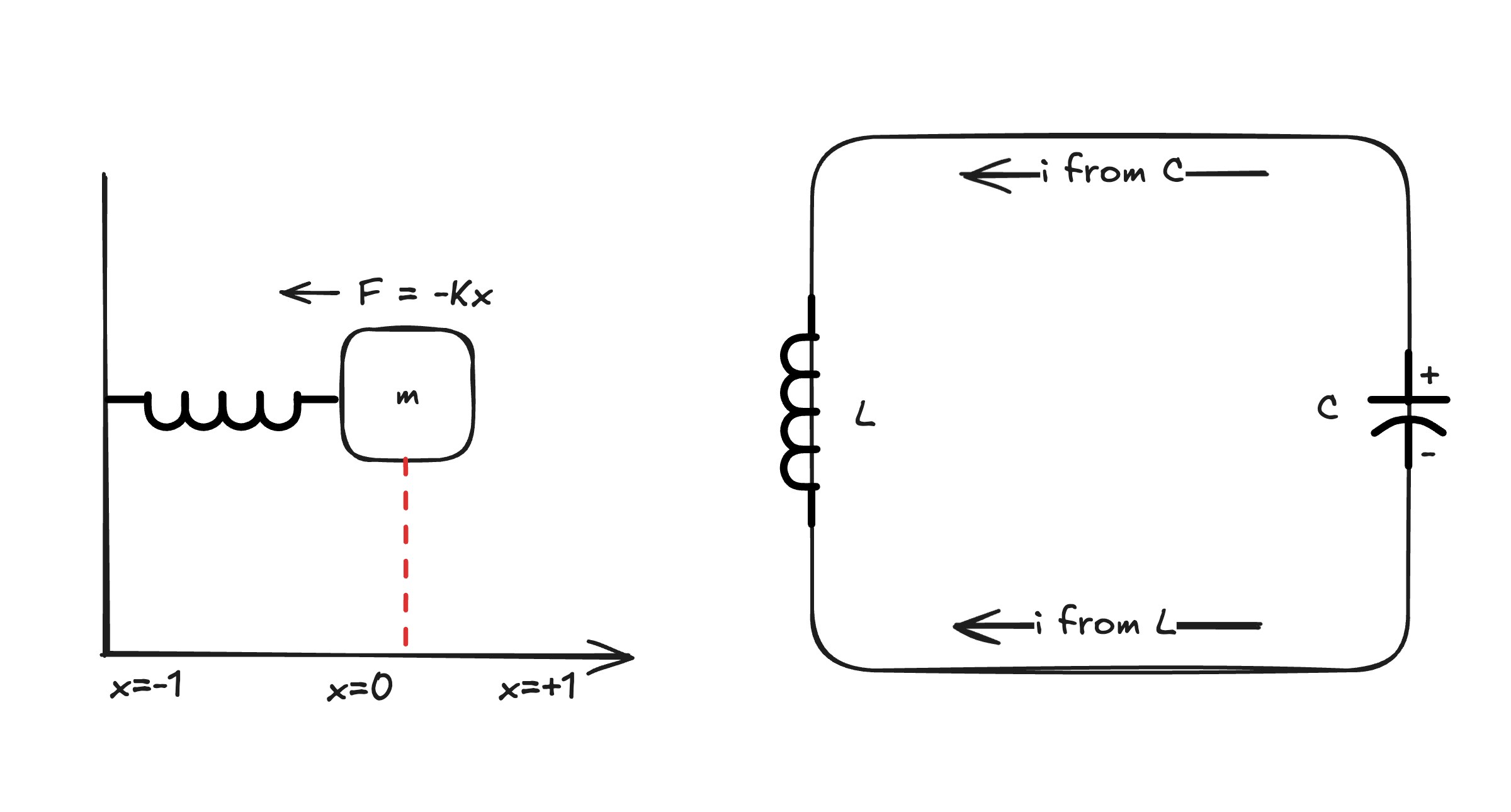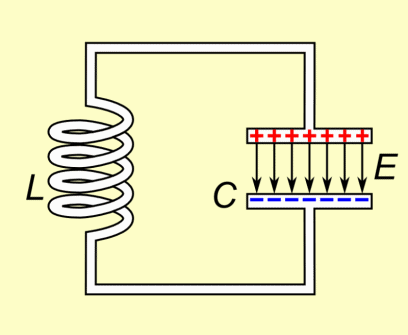Harmonic Oscillators (Part 1)
A weight on a spring has a mathematical similarity with an electrical circuit consisting of a capacitor and inductor (LC circuit). They are both examples of harmonic oscillators which exhibit a sinusoidal behavior through time.
Lagrange & Hamiltonian Review
Briefly, the Lagrangian is the difference of kinetic and potential energy ($T$ and $V$ respectively):
\[\mathcal L = T - V\]More accurately, the Lagrangian is any function that accurately describes a physical law when inputting it into the Euler Lagrange equations:
\[\frac{\partial \mathcal L}{\partial x} - \frac{d}{dt} \frac{\partial \mathcal L}{\partial (\frac{dx}{dt})} = 0\]The Hamiltonian is the total energy in a system:
\[H = T + V\]And is a reformulation of Lagrangian Mechanics describing the same physical phenomena. If $\frac{dH}{dt} = 0$, then energy is conserved. Hamilton’s equations are the analog of Euler Lagrange equations.
I have written about Lagrangians & Hamiltonians in previous posts (Lagrangians, Hamiltonians, Lagrangians & physics fields), refer to these for more details.
Mechanical Harmonic Oscillator
Given a spring applying a force $F = -Kx$ to a mass $m$1, we can write the Hamiltonian and Lagrangian as:
\[\begin{align*} H = T + V = \frac{1}{2}m(\frac{dx}{dt})^2 + \frac{1}{2}Kx^2 \\ \mathcal L = T - V = \frac{1}{2}m(\frac{dx}{dt})^2 - \frac{1}{2}Kx^2 \end{align*}\]Which gives the following Euler Lagrange Equation:
\[\begin{align} \frac{\partial \mathcal L}{\partial x} - \frac{d}{dt} \frac{\partial \mathcal L}{\partial (\frac{dx}{dt})} = -Kx - m \frac{d^2x}{dt^2} = 0 \label{eqn:mechanical_lagrange} \end{align}\]And can be rewritten into Newton’s second law:
\[-Kx = m \frac{d^2x}{dt^2} \implies \boxed{F = ma}\]If we were to solve this second order linear differential equation $\eqref{eqn:mechanical_lagrange}$, we would get a wave:
\[\begin{align*} x(t) = A \sin{(\omega t + \phi)} \\ \omega = \sqrt{\frac{K}{m}} \end{align*}\]Finally, we have energy conservation by showing $\frac{dH}{dt} = 0$:
\[\begin{align*} \frac{dH}{dt} &= \frac{\partial H}{\partial t} + \frac{\partial H}{\partial x}\frac{\partial x}{\partial t} + \frac{\partial H}{\partial (\frac{dx}{dt})} \frac{d^2 x}{dt^2} \\ \frac{dH}{dt} &= 0 + Kx \frac{dx}{dt} + m \frac{dx}{dt} \frac{d^2 x}{dt^2} \\ \frac{dH}{dt} &= \frac{dx}{dt}(Kx + m \frac{d^2 x}{dt^2}) = 0 \end{align*}\]Where the last equality comes directly from the Euler Lagrange Equation (or Newton’s second law).
Electrical Harmonic Oscillator (LC Circuit)
The LC circuit (or “tank” circuit) will consist of the following elements2
- Capacitor $C$
- $Q = Cv_C$
- $\frac{dQ}{dt} = i = C \frac{dv_C}{dt}$
- $E_C = \frac{1}{2}Cv_C^2$ (Energy of capacitor)
- Inductor $L$
- $v_L = L \frac{di}{dt}$
- $E_L =\frac{1}{2}Li^2$ (Energy of inductor)
More on $i$
From Lenz’s law we know that the current induced in a circuit due to a change in a magnetic field is directed to oppose the change in flux and to exert a mechanical force which opposes the motion.
Since the capacitor will be sending current through the inductor which creates a magnetic field, the inductor will then have an electromotive force (emf) which affects the capacitor. The following animation from wikipedia visualizes this:
You can read more about this progression here.
For an LC circuit, these components will have the following Hamiltonian:
\[H = \frac{1}{2}Cv_C^2 + \frac{1}{2}Li^2\]And Lagrangian,
\[\mathcal L = \frac{1}{2}Cv_C^2 - \frac{1}{2}Li^2\]Unlike in the mechanical example where we had the coordinate system $x$, our energy expressions involve different time-dependent quantities, $v$ and $i$. We can unify the “state” of the system to be the charge $Q$ at time $t$, $Q(t)$.
\[\begin{align*} \mathcal L &= \frac{1}{2}Cv^2 - \frac{1}{2}Li^2 \\ &= \frac{1}{2}C \frac{Q^2}{C^2} - \frac{1}{2}L (\frac{dQ}{dt})^2 \\ &= \frac{1}{2C} Q^2 - \frac{1}{2}L (\frac{dQ}{dt})^2 \end{align*}\]Now we can apply Euler Lagrange like before to work out the equations of motion:
\[\begin{align} \frac{\partial \mathcal L}{\partial Q} - \frac{d}{dt} \frac{\partial \mathcal L}{\partial (\frac{dQ}{dt})} = \frac{Q}{C} - \frac{d}{dt} (-L\frac{dQ}{dt}) = \frac{Q}{C} + L\frac{d^2Q}{dt^2} = 0 \label{eqn:electric_lagrange} \end{align}\]Now we will apply the definitions of capacitance and inductance from above:
\[\frac{Q}{C} + L\frac{d^2Q}{dt^2} = \frac{Q}{C} + L\frac{di}{dt} = v_C + v_L = 0\]Which is Kirchhoff’s voltage law:
\[v_C + v_L = 0 \implies \boxed{\sum_{i=1}^{n}v_i = 0}\]As before, we can show that the energy of the system is conserved:
\[\begin{align*} H &= \frac{1}{2C} Q^2 + \frac{1}{2}L (\frac{dQ}{dt})^2 \\ \frac{dH}{dt} &= \frac{\partial H}{\partial t} + \frac{\partial H}{\partial Q}\frac{\partial Q}{\partial t} + \frac{\partial H}{\partial (\frac{dQ}{dt})} \frac{d^2 Q}{dt^2} \\ &= \frac{Q}{C}i + L i \frac{d^2 Q}{dt^2} \\ &= i(\frac{Q}{C} + L \frac{d^2 Q}{dt^2}) \\ &= 0 \end{align*}\]Where the last equality came from the equations of motion.
Relating Electrical and Mechanical Harmonic Oscillators
There is a high degree of similarity between the mechanical and electrical harmonic oscillators,
| Mechanical Oscillator | Electrical Oscillator | |
|---|---|---|
| Hamiltonian | $\frac{1}{2}m(\frac{dx}{dt})^2 + \frac{1}{2}Kx^2$ | $\frac{1}{2}L (\frac{dQ}{dt})^2 + \frac{1}{2} \frac{1}{C} Q^2$ |
| Eqn of Motion | $\frac{d^2}{dt^2}x + \frac{K}{m}x = 0$ | $\frac{d^2}{dt^2}q + \frac{1}{LC}q = 0$ |
With the following substitutions we see they are the same second order differential equation:
- $x \rightarrow Q$
- $m \rightarrow L$
- $K \rightarrow \frac{1}{C}$
As a result, the solution of the LC circuit’s equation of motion must also be a wave:
\[\begin{align*} Q(t) &= A \sin{(\omega t + \phi)} \\ \end{align*}\]Where $\omega = \sqrt{\frac{1}{LC}}$ is the electrical analog for angular frequency. We can derive the rest of the time dependent quantities:
\[\begin{align*} i(t) &= \frac{dQ(t)}{dt} = \omega A \cos{(\omega t + \phi)} \\ v_L(t) &= L\frac{di}{dt} = -\omega^2 L A \sin{(\omega t + \phi)} \\ v_C(t) &= \frac{Q}{C} = \frac{A}{C} \sin{(\omega t + \phi)} \end{align*}\]Visualizing LC Circuits with Plots
Here is a visualization of the equations we computed above, plotted in the domain $t \in [0, 2\pi]$:
Some important points:
- Voltage through the capacitor and inductor are equal but opposite.
- Current leads the capacitor’s voltage but lags behind the inductor’s voltage.
- $H(t)$ is conserved at all times.
Code Snippet
Visualizing LC Circuits with Simulation
We can also visualize the LC circuit using this great circuit simulator by Paul Falstad. To learn more about the “Resistance” parameter, check out my next post on RLC circuits.
References
https://eng.libretexts.org/Bookshelves/Electrical_Engineering/Electro-Optics/Direct_Energy_(Mitofsky)/11%3A_Calculus_of_Variations/11.04%3A_Mass_Spring_Example ↩︎
https://eng.libretexts.org/Bookshelves/Electrical_Engineering/Electro-Optics/Direct_Energy_(Mitofsky)/11%3A_Calculus_of_Variations/11.05%3A_Capacitor_Inductor_Example ↩︎

